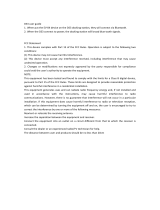
APsystems DS3 Series Installation manual
Table of Contents
1. Important Safety Instructions......................................................................................................... 2
1.1 Safety Instructions.......................................................................................................................................... 2
1.2 Radio Interference Statement........................................................................................................................ 3
1.3 Symbols in lieu of words.................................................................................................................................4
2. APsystems Microinverter System Introduction .............................................................................. 4
3. APsystems Microinverter DS3 Series Introduction ........................................................................ 7
4. APsystems Microinverter System Installation ................................................................................ 8
4.1 Additional accessories supplied by APsystems..............................................................................................8
4.2 Other required accessories not supplied by APsystems ............................................................................... 8
4.3 PV Rapid Shut Down Equipment .................................................................................................................... 9
4.3 Installation Procedures.................................................................................................................................10
4.3.1 Step 1 - Verify that grid voltage matches microinverter rating........................................................ 10
4.3.2 Step 2 – Y3 AC Bus Cable distribution...............................................................................................10
4.4.3 Step 3 - Attach the APsystems Microinverters to the Racking......................................................... 10
4.4.4 Step 4 - Ground the system ...............................................................................................................11
4.4.5 Step 5 - Connect the APsystems microinverter to AC bus cable...................................................... 11
4.4.6 Step 6 - Install a Bus Cable End Cap at the end of AC bus cable...................................................... 12
4.4.7 Step 7 - Connect APsystems Microinverters to the PV Modules ......................................................13
4.4.8 Step 8 - Connect APsystems Microinverters to Grid.........................................................................14
4.4.9 Step 9 - AC Extension Cable.............................................................................................................. 14
4.4.10 Step 10 - Complete the APsystems installation map...................................................................... 15
5. APsystems microinverter system operating instructions .............................................................16
6. Troubleshooting .............................................................................................................................17
6.1 Status Indications and Error Reporting ........................................................................................................ 17
6.1.1 Start up LED ....................................................................................................................................... 17
6.1.2 Operation LED................................................................................................................................... 17
6.1.3 GFDI Error.......................................................................................................................................... 17
6.2 ECU_APP....................................................................................................................................................... 17
6.3 Installer EMA (web portal or EMA Manager APP)....................................................................................... 17
6.4 Trouble Shooting Guide................................................................................................................................17
6.5 APsystems Technical Support....................................................................................................................... 18
6.6 Maintenance .................................................................................................................................................18
7. Replace a microinverter ................................................................................................................ 19
8. Technical Data ................................................................................................................................20
8.1 DS3 series Microinverter Datasheet............................................................................................................ 21
9. Wiring Diagram ..............................................................................................................................22
9.1 Sample Wiring Diagram - Split Phase ........................................................................................................... 22
9.2 DS3 Connected to high leg detla grid ...........................................................................................................23
10.DS3 series Accessory ................................................................................................................ 24
10.1 Dimensions .............................................................................................................................................. 24
10.2Wiring Diagram .........................................................................................................................................25
11. APsystems Microinverters Installation Map ...............................................................................26
























